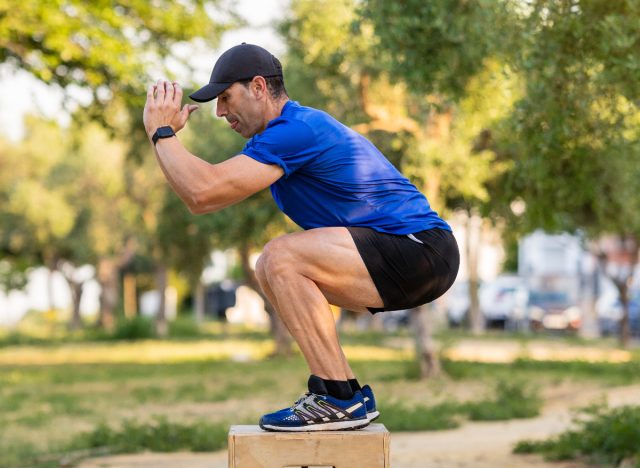Engaging in high-impact activities is advantageous for individuals aiming to enhance their stamina and muscle power. Nevertheless, these activities can also impose excessive strain on your joints. While high-intensity exercises such as plyometrics, running, and sprinting are renowned for their ability to burn a high number of calories, they can quietly harm your joints. We consulted with a fitness instructor who has identified six high-impact exercises that have the potential to harm your joints, so you can steer clear of them in your workout routines.
“High-impact exercises contribute to joint pain and long-term damage by placing repetitive stress on the joints, especially in weight-bearing areas like the knees, hips, and lower back,” explains Ronny Garcia, CPT, from Blink Fitness. “The constant impact can wear down the protective cartilage, leading to inflammation, pain, and conditions such as osteoarthritis.”
As time passes, your joints may lose their ability to successfully absorb shock, making them more susceptible to injury. Incorrect form or overuse while performing high-impact exercises further heightens your risk of ligament damage, joint strain, and chronic joint problems.
So, let’s explore the six high-impact exercises that can damage your joints, according to Garcia.
Running

Running on pavement can break down the cartilage in your lower back, hips, and knees. “The repeated impact of your feet on the hard ground can also cause inflammation and lead to arthritis over time,” Garcia adds.
An excellent alternative to running is the elliptical. This cardio machine provides a great, low-impact workout and the same cardiovascular benefits as running without straining your joints.
Jumping Jacks

The repeated jumping and landing motions of jumping jacks can be tough on your hips, knees, and ankles.
“Step jacks involve stepping to the side instead of jumping and are a good alternative that reduces impact while working the same muscles,” Garcia points out.
Box Jumps

Box jumps can be hard on your ankles and knees, as jumping onto and off a high surface places strain on these joints. It also heightens your chance of getting injured if your coordination or balance is lacking.
“Step-ups are an alternative that engages the same muscle groups and improves strength and balance while being gentler on the joints,” Garcia tells us.
Burpees

Burpees require you to repeatedly jump, squat, and push up, which can harm your lower back, knees, and wrists. “The fast pace and impact on the joints make it a high-risk exercise for joint health,” Garcia notes.
To lessen the impact of this exercise, a smart alternative would be to replace the jump with simply stepping back into a plank position.
Basketball and Other High-Impact Sports

High-impact sports such as basketball, tennis, and soccer can place substantial stress on your hips, knees, and ankles. “These sports all involve stopping short, jumping, and quick direction changes, and the combination of the impact and twisting motion often leads to joint pain and ligament strain,” explains Garcia.
Opt for low-impact workouts like cycling or swimming instead. Both still offer stellar cardiovascular benefits while being easy on your joints.
Sprinting

Last but not least, you likely knew sprinting would be on this list!
“Sprinting requires explosive power, which can overstress the knees, hips, and lower back, and the abrupt acceleration and short stops place you at risk for injury,” says Garcia.
Head to the rowing machine instead for a productive, low-impact workout that recruits your entire body. “It avoids the jarring impact of sprinting while strengthening muscles and improving endurance,” Garcia adds.
Frequently Asked Questions (FAQs)
Why are high-impact exercises beneficial?
High-impact exercises are beneficial as they help with cardiovascular fitness, bone density, weight management, and overall strength. These exercises typically involve jumping, running, or other movements that force you to work against gravity.
What are some examples of high-impact exercises?
- Running
- Jumping jacks
- Burpees
- Aerobics
- Box jumps
How can high-impact exercises potentially damage your joints?
High-impact exercises can cause damage to your joints due to the repetitive stress and force exerted on them. Over time, this can lead to wear and tear on the joints, potentially causing pain, inflammation, and injury.
What are the risks of doing high-impact exercises?
- Increased risk of joint injuries
- Worsening of existing joint conditions like arthritis
- Stress fractures
- Cartilage damage
- Tendonitis
How can you minimize the risk of joint damage while doing high-impact exercises?
To minimize the risk of joint damage while doing high-impact exercises, you can:
- Ensure proper warm-up and cool-down
- Wear supportive footwear
- Listen to your body and take breaks when needed
- Gradually increase intensity and duration of the exercises
- Consider alternating high-impact exercises with low-impact ones






